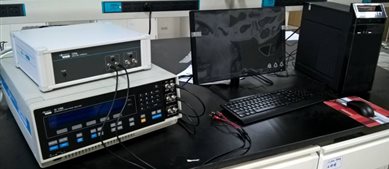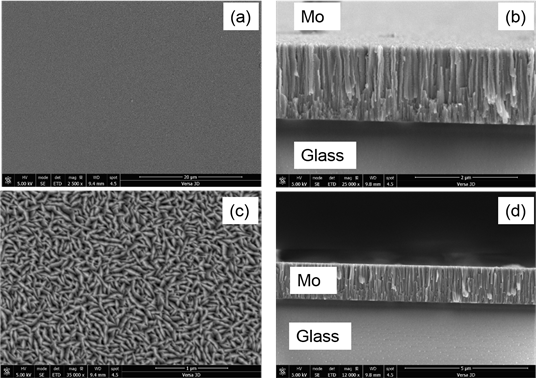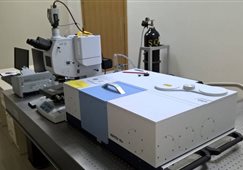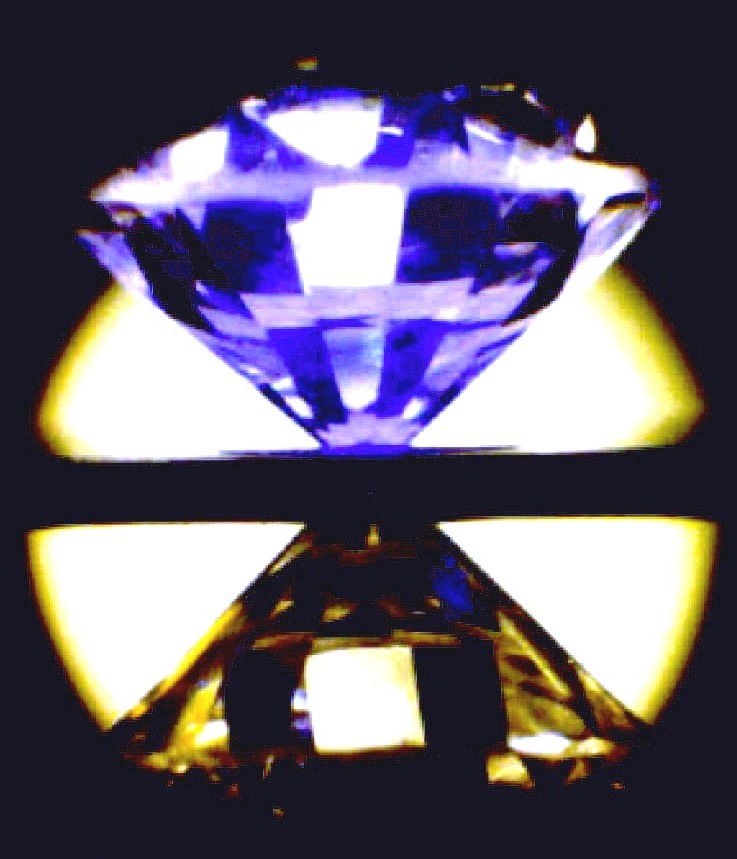
High-Pressure Devices | Analytical Equipments | Assistant Tools |
2. Multi-anvil Press | 2. X-ray Diffractometer | 2. Gas Loading |
4. Glovebox | ||
| 6. Ultrafast Pump-Probe Spectrometer | |
| 7. FIB/SEM | |
| 8. Impedance |
|
| 9. PPMS |
|
| 10. MPMS |
|
| 11. Brillouin Scattering System |
|
High-Pressure Devices
Multi-anvil
Analytical Equipments
Ultrafast
Brillouin
Assistant Tools
Laser-heating
Sputtering
| This gas-loading system is designed to load gases at high pressure into diamond anvil cells. The system has the ability to load many kinds of diamond anvil cells with a closure mechanism using motor driven screws which close a clamping device, not the cell itself. This design makes it easy to pressurize new cell designs by using a different clamp or different spacer. The gases can be loaded at pressures up to 29000 PSI, The gases to be loaded will be primarily Helium, Neon, and Hydrogen. The system has optical access for sample viewing and online ruby fluorescence pressure measurement. A vacuum pump is used to clean the system before loading. |
Gas-loading system |
Contact: Haiyun Shu (hy.shu@hpstar.ac.cn; 13127998486)
Ref: Rivers et al.,"The COMPRES/GSECARS gas loading system for diamond anvil cellsat the Advanced Photon Source", High Pressure Res. 28, 273 (2008).
HPSTAR laser-heating system has two ytterbium fiber lasers and spectrometers to provide double-sided heating and temperature measuring. Sample can be heated to as high as 3000K and temperature starting from 1000K can be measured precisely.
Key Parameters:
Laser Wavelength:1070nm;
Laser Power: 100WX2
Spectrometer:
Grating:density 300g/mm, Blaze500nm
Spectrumrange: 500-950nm
Camera: thermoelectriccooled CCD Sample environment:
Heating spot size at sample: 30um
Workingdistance: 35mm
DAC holder: Water cooled
Capabilities: DAC HT-HP samplesynthesis, HT-HP resistancemeasurement.
Contact: Xueyan Du, Email: xueyan.du@hpstar.ac.cn
Ref: G. Shen et al., Melting and crystal structure of iron at high pressures and temperatures, Geophys. Res. Lett. 25, 373 (1998).
laser-heating |
Absorbed pump light at 532 nm excites the Cr ion into excited states. The lifetime of these levels is short 3+ (50 ns), so that the excited ion quickly relaxes by making a transition to the long-lived metastable state. The energy which is lost in this process is nonradiative and goes into heating the crystal by generating phonons or vibrational excitations of the crystal atoms. The metastable energy level must have a lifetime which is long enough to enable the Cr ions to remain excited until a photon having the precise energy comes along to de-excite it.The lasing line in ruby is the so-called "R1-line" having a wavelength of 694.3 nm. The fluorescence lifetime of the R1-line is several ms. |
Example of ruby fluorescence at high pressure |
|
| Shematic layout of Ruby system |
With increasing pressure, this R1 fluorescence shifts to lower energies which provides us with an accurate estimation of pressure inside the sample c hamber of a DAC. Capabilities: The Ruby system is mainly used for pressure measurement in DAC. Contact: Weitao Ding, weitao.ding@hpstar.ac.cn. Ref: Dewaele A., Torrent M., Loubeyre P. and Mezouar M., Phys. Rev. B 78, 104102 (2008); Mao H.K., Xu J., and Bell P.M. J. Geophys. Res. 91, 4673, (1986). |
Capabilities and Key paremeters:
Currently it consists of 36 (8-core) IntelXeon E5-2650 v2 and v3 processors (560 cores in total), interconnected with 56Gb FDR infiniband.
Memory capacity: 64 Gb DDR4 EEC
Storage: 64 Terabytes
Operating system: Centos 6.0
Software: Intel compiler, OpenMPI
Scientific computing software: VASP, CPMD, WIEN2k, CP2K, LAMMPS, DLPOLY, GULP
Potential research fields:
Computational Physics on multi-scales –from first-principles to mesoscale modeling.
Directions: band-structure calculation,structure prediction, phase transitionsof materials, liquid-liquid transition, spectroscopy studies, new algorithm development.
Contact: Howard Sheng, hw.sheng@hpstar.ac.cn.
 The 1260 Impedance/Gain-Phase Analyzer uses powerful microprocessor-controlled digital and analog techniques to provide a comprehensive range of impedance and frequency response measuring facilities. The 1296 Dielectric Interface is a development of the Chelsea Dielectric Interface, it extends the capability of 1260 and enables 1260 to be used for a wide range of materials testing.
The 1260 Impedance/Gain-Phase Analyzer uses powerful microprocessor-controlled digital and analog techniques to provide a comprehensive range of impedance and frequency response measuring facilities. The 1296 Dielectric Interface is a development of the Chelsea Dielectric Interface, it extends the capability of 1260 and enables 1260 to be used for a wide range of materials testing.
| Key parameters & capabilities: | Potential Research Directions: |
Current Measurement: 1A to 100mA Tan Delta Range: <10-4 to 103 (10-2 to 103 at > 1MHz) in ref. mode Impedance Range: 100 Ω to >100 TΩ Capacitance Range: 1pF to >0.1F Frequency Range: 10μHz to 10MHz Signal Amplitude: Up to 7Vrms DC Bias: Up to 40V | High pressure physics Corrosion studies Battery research and fuel cells Solar cells LCDs Bio-materials Electronic component development Civil engineering |
Contact: Xiaojiang Li, xiaojiang.li@hpstar.ac.cn.
| Magnetron sputtering has been established as the process of choice for the production of many industrially important coating/substrate systems. With the development of magnetron sputtering technology, more and more functional thin film materials could be obtained using it. Single Chamber Magnetron Sputtering System is a high vacuum multi-functional magnetron sputtering deposition equipment, which offers an ideal solution for new materials and research field of thin films.
|
Magnetron Sputtering System |
Capabilities and Key parameters: It could be used to prepare various metal films, dielectric films, and semiconductor film. Magnetic films can also be fabricated through ferromagnetic material (Fe, Co, Ni) sputtering. Potential research directions: Materials science. Contact: Hongliang Dong, hongliang.dong@hpstar.ac.cn. Ref: P. J. Kelly. Recent advances in magnetron sputtering. Surface and Coating Technology, 112, 170-172 (1999). | SEM images of Mo films deposited on glass silica |
 The microscope-infrared spectrometer is composed of the Bruker VERTEX 70v vacuum FT-IR spectrometer with the HYPERION-2000 microscope. It can measure the liquid and solid in transmission and reflection mode. The measure range can cover the far IR (50 cm-1 to 600 cm-1) and mid IR (350 cm-1 -8000 cm-1). It can also measure the IR under the in-situ high pressure environment and do the IR mapping by the HYPERION-2000 microscope. Both the transmission and reflection mode can be used and the measure range is in the mid IR (600 cm-1 -8000 cm-1).
The microscope-infrared spectrometer is composed of the Bruker VERTEX 70v vacuum FT-IR spectrometer with the HYPERION-2000 microscope. It can measure the liquid and solid in transmission and reflection mode. The measure range can cover the far IR (50 cm-1 to 600 cm-1) and mid IR (350 cm-1 -8000 cm-1). It can also measure the IR under the in-situ high pressure environment and do the IR mapping by the HYPERION-2000 microscope. Both the transmission and reflection mode can be used and the measure range is in the mid IR (600 cm-1 -8000 cm-1).
Key Parameters & Capabilities:
Spectral Range: for the in-situ high pressure measurement and the IR mapping: mid IR (600 cm-1 -8000 cm-1); for the routine measurement: far IR (50 cm-1 to 600 cm-1) and mid IR (350 cm-1 -8000 cm-1)
Spectral Resolution: better than 0.4 cm-1
Measurement mode: transmission and reflection mode
Working distance of the microscope: 25 mm
Lens: 4×magnification objective, 15×magnification objective, 10×binoculars with adjustable eyepieces
Potential Research Directions: In-situ high pressure chemistry; Polymers and chemistry; Surface analysis; Semiconductors
Email: xiaojiang.li@hpstar.ac.cn
FEI Versa 3D dual-beam FIB/SEM (focused ion beam/scanning electron microscope) system is the most versatile high-resolution FIB/SEM for 2D and 3D material characterization and analysis. The instrument combines innovative electron and ion optics. Field emission electron beam optics with NG Schottky emitter sourceis optimized for high brightness/high current, providing low-noise imaging and field emission focused ion beam optics with liquid Gallium ion emitter has fast high-volume milling capabilities. Capabilities: 1. Micro Machining The site specific nature of the dual-beam system milling capability allows preparation and processing of materials in ways that are limited only by one's imagination. It can machine graphics, such as concave, convex, rectangular, spherical or irregular shape.
|
FIB workstation
|
| A primary advantage to the lift-out technique over other specimen preparation methods is that specimens may be prepared from the starting bulk sample with little or no initial specimen preparation. The lift-out method also has significant implications in the overall analytical approach to a site-specific problem. Besides, the lift-out technique is very useful for TEM sample preparation and often used to lift out the sample and in-situ combination. | |
EasyLift NanoManipulator transfer gasket and diamond | |
3. Scanning Electron Microscope (SEM): Qualitative chemical analysis and/or crystalline structure; Chemical analyses using EDS; Mapping to analyse the grain size, grain boundary, grain orientation and texture using EBSD.
4. CVD deposition or enhanced etching: 4 gas injector system for in-situ deposition and enhanced etching of carbon-based materials such as resist, polycarbonate or diamonds.
Potential research directions: Material Science, Chemistry, Physics, Earth Science.
Contact: Yanping Yang (Yanping.yang@hpstar.ac.cn)
Ref: Giannuzzi and Stevie, "Introduction toFocused Ion Beams: Instrumentation, Theory,Techniques, and Practice" (Springer, New York,2005)
|
Laser-drilling |
The laser-drilling system contains 50 mw laser with 1064 nm wavelength. The system allows drilling in pre-indented gasket with micro precision and ensures a well-centered hole. It’s also used for cutting gaskets for inner-resistive heating study.
Key parameters: 50 mw laser with 1064 nm wavelength.
Hole in drilling |
Capabilities: Drilling and cutting.
Contact: Weitao Ding, Email: weitao.ding@hpstar.ac.cn
Potential research direction: High-pressure science.
The MB-200B modular platform is designed with the capability to add further box tops onto existing workstations, connecting directly to any standard MBRAUN gas purification system. Key parameters: Attainable purity level H2O < 1 ppm, O2 < 1 ppm. Frequency controlled multi-speed blower: flow rate of 12m3/h. Moisture probe: 0-500 ppm. Oxygen probe: 0-1000 ppm. Solvent removal systems: Filled with 5kg atctivaed charcoal, type A. |
Glovebox |
The device help perform tasks inside the box without breaking containment. The transparent to allow the user to see what is being manipulated.
Capabilities: Hazardous/sentative sample loading in DAC.
Contact: Fei Chen, fei.chen@hpstar.ac.cn
Ref: Aranki et al., "Isolation of anaerobic bacteria from human gingiva and mouse cecum by means of a simplified glove box procedure", Appl. Environ. Microbiol., 17. 4568-576 (1969).
Raman |
The RenishawinVia Raman system has three interchangeable holographic gratings and a silicon CCD detector (576 x 384-pixel, Peltier-cooled to -70°C) to provide high sensitivity. Samples are analysed on a specially adapted Research Grade free space microscope equipped with oculars, a colourvideo camera, objectives and a motorized sub-micron resolution XY- and Z-travelstage. The samples can be probed by a range of laser wavelengths for different capibilities/applications. The spectrometer and microscope are fully computer-controlled by Windows-compatible software which acquires the Raman data, captures the video images, and searches for the minerals and polymer database.
Key parameters:
Laser source | Total Power | Grating | Range of spectrum |
300 mW | 1200 g/mm | 50-9000 cm-1 | |
HeNe laser-633 nm | 17 mW | 1800 g/mm | 50-9000 cm-1 |
Nd:YAG laser-532 nm | 100 mW | 2400 g/mm | 100-9000 cm-1 |
30 mW | 2400 g/mm | Raman:200-4000 cm-1 PL:>365nm |
Capabilities: In-situ Raman spectroscopy and ruby-fluorescence pressure measurement.
Potential research directions: Fundamental physics and chemistry, materials, and earth and planetary science.
Contact: Zhongli Fan, Email: zhongli.fan@hpstar.ac.cn
Ref: Raman Spectroscopy and the Diamond Anvil Cell
|
|
Vacuum drying oven | Redox system |
|
|
Microscopes | Small processing center |
|
|
Magnetic stirrers | CNC lathe: Machining |
Quantum Design's MPMS 3 providing users with the sensitivity of a SQUID (Superconducting QUantum Interference Device) magnetometer and the choice of multiple measurement modes, the MPMS 3 offers new levels of performance in magnetic research.
Capabilities & Key parameters:
|
MPMS |
Magneticfield: -7-+7 Tesla
Temperature:1.9-1000 K
Ultralow magnetic field: <0.05Gauss
Magnetization
Electrical resistance
Potential research directions: Condensed Matter Physics
Contact: Xiaojia Chen, xjchen@hpstar.ac.cn
Ref: Wang et al., "Superconductivity at 32 K in single-crystalline RbxFe2−ySe2" Phys. Rev. B 83, 060512(R) (2011).
Empyren diffractometer is unique in its ability to measure all sample types on a single instrument, without compromising data quality. It has multiple chices for anode: Cu, Mo and Ag. It is able to cover small angle and wide angle scattering, and even pair distribution function.
Capabilities: · Powders · Thin films · Nanomaterials · Solids | Key parameters: X-ray tube maximum power output:2.2kW Angular resolution: 0.0001 degree Overall repeatability: 0.001 degree Anode material :Cu Beam size: 12*0.4 mm2 Soller slits: 0.04 rad |
Contact: Charles, zengqs@hpstar.ac.cn
Ref: Spurr and Myers, "Quantitative analysis of anatase-rutile mixtures with X-ray diffractometer", Anal. Chem. 29, 760-761 (1957)
The DSCs are elemental equipments for studying some physical, chemical processes of materials while subjecting to heating (e.g. crystallization, glass transformation).
Capability:
Thermal transitions in polymers; Characteristic-temperature measurement of amorphous materials, such as relaxation temperature, glass transition temperature, crystallization temperature, melting temperature and liquidus temperature; Oxidative stability test; chemical reactions, kinetic properties of transition, etc.
|
Perkin Elmer DSC8500 |
Key parameters of DSC8500:
Temperature range: -180 °C~750 °C
Controllable heating rate: 0.01-750 °C/min; Fastestcooling rate: 2100 °C/min
Temperature accuracy: ± 0.05 °C
Heat flow accuracy: ± 0.2%
Heat flow sensitivity: 0.18 µW
Data acquisitionrate: 100 points/s; Built-in TMDSC mode
Key parameters of DSC404:
Furnaces type: Rhodium;Temperature range: 25 °C-1650 °C
Fastest heating/cooling rate: 50 °C/min
Potential reserch dirctions: Basic characterization for amorphous materials.
Ref: Gabbott et al., "A highsensitivity,high-speed DSC technique: measurement of amorphous lactose", Am. Lab. 35, 17–18, 20, 22 (2003).
The Malvern NanoSightLM10 instrument provides an easy-to-use, reproducible platform for nanoparticle characterization.
Capabilities: The LM10 allows rapid andaccurate analysis of the size distribution and concentration of all types of nanoparticles from 10 nm to 2000 nm in diameter, depending on the instrument configuration and sample type.
Key parameters: Temperature range: 8 °Cbelow ambient up to 50 °C; Particle size: 10 nm to 2000 nm; Concentration range: 106 to 109 particles per ml.
Potential research directions: Research relative to particlesin liquid suspension.
|
NanoSightLM10 |
Contact: Hao Yan. yanhao@hpstar.ac.cn. Ref: Adeleye et al., "Persistence of commercial nanoscaled zero-valent iron (nZVI) and by-products", J.Nanopart. Res., 15,1418 (2013). | |
 The diamond anvil cell (DAC) technique takes the advantage of the unique properties of diamonds: highest hardness, transparent in a wide rage of electromagnetic spectrum. In a diamond anvil cell, a sample is pressurized by squeezing between two gem-quality diamonds. The sample is held within a small hole within a pre-indented thin steel/rhenium sheet with DAC. Extreme pressures (~400 GPa) can be readily achieved by using the diamond anvil cell.
The diamond anvil cell (DAC) technique takes the advantage of the unique properties of diamonds: highest hardness, transparent in a wide rage of electromagnetic spectrum. In a diamond anvil cell, a sample is pressurized by squeezing between two gem-quality diamonds. The sample is held within a small hole within a pre-indented thin steel/rhenium sheet with DAC. Extreme pressures (~400 GPa) can be readily achieved by using the diamond anvil cell.
Types and applications of DACs:
Mao-type symmetric cell: Angle-dispersive diffraction & double-sided laser heating |
Be-Cu cell: Electrical Transport measurement |
Cross-cell: Imaging/Inelastic scattering/radial diffraction |
Mao-type panoramic cell: Radial diffraction |
The Quantum Design PPMS represents a unique concept in laboratory equipment: an open architecture, variable temperature-field system, designed to perform a variety of automated measurements. It is an open architecture variable temperature-field system that is optimized to perform avariety of automated measurements, including the electro-transport, thermaltransport, magnetometry and heat capacity properties. Use the PPMS with specially-designed measurement options, or easily adapt it to your own experiments.
|
MPMS |
Capabilities & Key paremeters:
Magneticfield: -9-+9 Tesla
Temperature: 0.3-400 K
Sample Rotation: 0-360 degree
Electrical Transport
Thermal Transport
Thermal expansion
Heat Capacity
AC Susceptibility
Torque
Potential research directions: Condensed Matter Physics
Contact: Xiaojia Chen, xjchen@hpstar.ac.cn